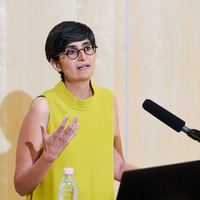Papers by Dhanraj A Patil

Dhanraj A.Patil(2023)The Upsurge of Subaltern Counterpublics: Community Radio, New Publics and Participatory Development Actions in Rural India,’ Chapter 8 (pp.228-247) In Kiran Odhav and Jayanathan Govender (Eds) “Handbook on Sociology of Inequalities in BRICS Countries,” Frontpage Publications ..., 2023
This paper ponders how we are to envisage the apocalyptic nature of dominant media and the emanat... more This paper ponders how we are to envisage the apocalyptic nature of dominant media and the emanation of alternative counter media, Community Radio Stations (henceforth CRs), its connected plurality of values such as rising subaltern counterpublics, constructing ‘new publics’ and their participatory development actions dawning in a highly stratified and complex country, India. Studies on community media are mostly analysed through the prism of the Hebermasian public sphere. However, Habermas’s public sphere bequeaths critical academic debates that cascade new concept of ‘subaltern counterpublics’ by Fraser. This paper seeks to enrich the discourse by incorporating Fraser's concept of 'subaltern counterpublics', which offers a more nuanced theoretical framework. Through an ethnographic investigation of two pioneering CRs located in the most deprived rural regions (Bundelkhand and Telangana), the paper argues that CRs have expanded democratic communicative spaces, instituting as an integral institution for common subordinate citizens’ counter-public sphere. Through these expanded spaces, CRs democratically view their listeners as new publics instead of solely as audiences, such cultural registers of public engagements translate into symbolic reproduction of rationalized life-worlds and as means of mediating participatory development actions at the local level. While acknowledging the democratic significance of CRs, the study is cautious about its sustainability challenges, growing digital poverty, NGOisation, and the refeudalisation of CRs, which are not pardoned.

International Journal of Rural Management, Apr 1, 2010
This article provides an in-depth review of rural electrification efforts in India; specifically ... more This article provides an in-depth review of rural electrification efforts in India; specifically it deals with the limitations of the definition of village electrification and the quantitative dilemma between village and household electrification. However, this article revolves around three main claims about Maharashtra’s first community bio-mass rural electrification project at Lonarwadi village in western Maharashtra: (a) The project has mainly benefited both the rural middle and below poverty line (BPL) class people. (b) Bio-mass electricity plays a modest role in supporting economically productive and education-related activities, particularly it reduces the everyday drudgery and pressure on women, but ‘connective’ applications such as television, radio and cellular telephone charging often receive a higher priority. (c) Bio-mass electrification is more closely tied to indoor lighting, education, health and increased television use, more rural-urban communication. Finally, it also shows the appropriate renewable technology movement and management for sustainable development.

Community based media initiatives in various parts of the world creating an ideal communicative a... more Community based media initiatives in various parts of the world creating an ideal communicative atmosphere to encourage democratization of information, participatory local development, mainstreaming gender equality and non-formal education. The Indian context is not an exception to this reality. Among the various media, in particularly community radio has been emerging as powerful source for empowerment, especially for disenfranchised and marginalized groups in Indian society. Since MacBride commission internationally scholars from media and development studies are fanatically involved in conducting research to explore various facets of such communicative processes at grassroots level. The present book can be seen as a potential contribution especially from the south towards the developments in the area of communication for development (C4D) at global level. The book is based on ethnographic accounts of two pioneering community radio stations in the most marginalised regions of Indi...

IASSI-Quarterly, 2020
The denotified, nomadic and semi-nomadic tribes (DTNT & SNT’s) are one of the most subjug... more The denotified, nomadic and semi-nomadic tribes (DTNT & SNT’s) are one of the most subjugated groups of Indian society. Due to the historic injustice as roofed as delinquent subjects they continue to remain at the periphery of development and struggling for their constitutional right to justice, equality and freedom. This paper attempts to explore few intricate questions for instance: Why are they not accommodated and represented adequately as legitimate citizens of democracy? and Are they victims of the politics of accommodation and the targets of developmental governmentality? To investigate the research problem under investigation the paper applies critical discourse-method and “politics of accommodation and governmentatility” as prime methodological and theoretical foundations. The paper concludes that (DTNT & SNT’s) have become the hapless-victims of the politics of accommodation since colonial-period and the postcolonial state also failed to decolonise this false construction, tactically. The paper suggest that, the meaningful accommodation of (DTNT & SNT’s) in the democratic structures is intuitively centred on i) how state and the larger society build necessary and sufficient conditions and ii) time bound strategic action framework and rightful dialog with democratic and political institutions upon whom the onus lies for the welfare of historically disenfranchised communities.

The taxonomy of democracy in the present era is somewhat perplexing. The crumple of socialist par... more The taxonomy of democracy in the present era is somewhat perplexing. The crumple of socialist paradigm and the upsurge of digital age paved way to cement fundamental institutions together with democracy. With the leap in new digital technologies (hereafter NDT's) like Artificial Intelligence (AI) and Social Media Platforms (hereafter SMP's) will have the potential to effect the kinds of social change that will shape modern digital democracies in the very near future. The Indian democracy is in transitory phase manifesting from representative to participatory democracy. However, these newely emerging complex techno-social participatory relationships unlock new opportunities and challenges. Although fragile and clouded, an attempt has been made to foresee the societal consequences of the interrelationships between forms of future democratic participation (FDP) and (NDT's) in the era of digital India in 2030. In the light of above intricacies, a qualitative inquiry has been...

More than 850 million people in developing countries are excluded from a wide range of informatio... more More than 850 million people in developing countries are excluded from a wide range of information and knowledge, with the rural poor in particular remaining isolated from both traditional media and new information and communication technologies, which would improve their livelihoods and development pattern (FAO, 2001).Considering the sociocultural and geographical structure of rural, remote people community radio has been found more effective and inclusive medium to provide equitable information and knowledge among the masses. The aim of this article is to analyze the contribution of community radio (henceforth CR) movement for conscientization and development of deprived rural people in various parts of world in general and south Asia (India) in particular. The analysis indicates that the community radio movement has created grassroots-level participation and horizontal circulation of ideas among the deprived rural communities, which are necessary pre-conditions to democratization...

Noise pollution and allied health problems are seen at all ages worldwide. This is due to increas... more Noise pollution and allied health problems are seen at all ages worldwide. This is due to increase in mechanization in industries, transportation as well as home appliances produce high level of noise. Noise Induced Hearing Loss (NIHL) is common health complaint found in industrial workers. The present research work reveals the NIHL problem in workers related to saw mill and printing press in Akluj town, Solapur district of Maharashatra state. For the present study measurement of noise levels are done in saw mills and printing presses. The standard noise level value is calculated in respective locations. Noise Induced Hearing Loss (NIHL) among the workers is measured by an Audiometer. 420 workers, viz. 250 from ten saw mills and 170 from ten printing presses respectively were investigated to find out NIHL. The average noise levels in printing press and saw mill are 90.2 dB and 79.3 dB respectively. Whereas standard noise level (Leq) in above locations are 101.4 dB and 98.7 dB respec...

Turkish Online Journal of Qualitative Inquiry , 2012
The diabolical policy approaches and apparatus constructed by colonial state and further reconstr... more The diabolical policy approaches and apparatus constructed by colonial state and further reconstructed by post-colonial state under the tactical visions of governmentality and politics of accommodation jeopardised millions of Nomadic and De-notified Tribes NTDNTs. Thus, once located on mainstream of society the NTDNTs are pushed at the bottom of the lowest rungs of socioeconomic and political hierarchy. Against this backdrop, the paper aims to examine the long-troubled trajectory of NTDNTs throwing light on continuities of governmentality and politics of accommodation grounded during colonial-post colonial states methodically captured through (19) select cases of policy approaches and apparatus, respectively. The paper uses life stories of NTDNTs and their envoys voices as prime qualitative method for analyses using hermeneutics tradition. The paper through conceptual lens of governmentality and politics of accommodation concludes that the immensity of NTDNTs subjugation and exclusion instituted by colonial-postcolonial state is the vexing case of world's most elongated hapless victims of 'governmentality and politics of accommodation' beyond the pale of social-accountability. Finally, the paper put-forth unfeigned future policy priorities (FPPs) coupled with integrated model of change actors upon whom the onus lies to ensure NTDNTs reintegration and legitimate possibility of developmental accommodation for a new democratic India.
The villages epitomize the soul of India. With more than 70% of the Indian population living in r... more The villages epitomize the soul of India. With more than 70% of the Indian population living in rural areas. rural India reflects the very essence of Indian culture and tradition. A holistic development of India as a nation rests on a sustained and holistic development of rural India. Information and Communication Technology (ICT) has emerged as an effective facilitator in the development of any society and is a prime driving force in the growth of economies worldwide. In this context ICT have a lot to offer for developing the rural sector. This paper provides an account of some of the major initiatives, particularly those touching the rural domain. It also highlights the impact of ICT efforts on the rural society.

Current Science, 2008
The urban centres of India produce 120,000 t of solid waste per day. The unscientific disposal of... more The urban centres of India produce 120,000 t of solid waste per day. The unscientific disposal of solid waste creates many environmental and pollution problems. The 1000-1200 t of solid waste in Pune municipal area is disposed at Urali-Devachi village. This communication reveals the problems of air and groundwater pollution caused due to unscientific disposal of solid waste observed at Urali-Devachi village. The average annual emission of SPM found at the disposal site is 1708.3 μg/m 3 . The average annual emission of SO 2 in landfill site is 285.33 μg/m 3 and NO x is 234.07 μg/m 3 . The SPM, SO 2 and NO x concentrations are more than those stipulated by the Indian standard limit. The leachate samples are acidic and corrosive in nature. The COD and BOD of tested well-water samples III and IV are 834, 703 mg/l and 716, 412.16 mg/l respectively. The concentration of sodium in well-water samples III and IV is 2437 and 2612 mg/l respectively. The COD, BOD and sodium concentration in wel...
Journal of Health Informatics in Developing Countries, 2011
Mobile technology is emerging as the first extensive form of electronic communication which is cu... more Mobile technology is emerging as the first extensive form of electronic communication which is culturally and socially feasible and appropriate for strengthening health system. As a public health intervention, the world of mobile is just beginning. The essay analyses the role of mobile technology for public health by using 4 Ps of marketing mix-products and services, price, place, and promotion from social marketing perspective and also show how it helps for democratizing public health programs in the developing world.

INTERNATIONAL JOURNAL OF EDUCATIONAL SCIENCES, 2021
The denotified, nomadic and semi-nomadic tribes (DTNT and SNT’s) are one of the most subjugated g... more The denotified, nomadic and semi-nomadic tribes (DTNT and SNT’s) are one of the most subjugated groups in Indian society. Due to the historic injustice they continue to remain at the periphery of development and struggling for their constitutional right to justice, equality and freedom. This paper attempts to explore few intricate questions for instance: Why they are not accommodated and represented adequately as legitimate citizens of democracy? and Are they victims of the politics of accommodation and the targets of developmental governmentality? To investigate the research problem under investigation the paper applies critical discourse method and “politics of accommodation and governmentatility” as prime theoretical foundations. The paper concludes that (DTNT and SNT’s) have become the hapless victims of the politics of accommodation since colonial period and the post-colonial state also failed to decolonise this false construction tactically. The paper suggest that the meaningf...

Journal of Rural and Development, 2012
Modern agriculture practices have been great promise for economic development of nation. Farm pro... more Modern agriculture practices have been great promise for economic development of nation. Farm productivity is directly proportional to use of agrochemicals as observed from the first green revolution. Improper and unsafe use of these agrochemicals, especially pesticides is not only harmful to environment but also human health. Pesticides cause 14 per cent of all known occupational injuries in agriculture and 10 per cent of all fatal injuries. The relationship between the extent of pesticide-use and signs and symptoms of illnesses due to exposure among agricultural labourers of one of the high cash crop zones of Maharashtra State (Western Maharashtra) was assessed. Total 100 agricultural labourers were interviewed with pre-tested interview schedules by using accidental sampling procedure. It is found that more than 75 per cent of labourers used either "moderately hazardous" or "highly hazardous" pesticides as classified by World Health Organisation (WHO). However,...

This article aims to find the ecological practices by the Magarpatta City SEZ have reflections of... more This article aims to find the ecological practices by the Magarpatta City SEZ have reflections of conceptual perspective of Ecological Modernisation. Magarpatta City SEZ is unique example and appreciated for all the social, economic and ecological controversies by other SEZs in India. This exploratory and descriptive study based on the collected information from the field visits and secondary resources. Magarpatta City SEZ is laid with proactive and environmental outlook. This is unique for its pollution free and clean urban environment were visitors are impressed to look the nature conservative practices. Eco-friendly practice of segregation of over 400 tones of household and commercial garbage, trash and water per month is done at source of which 280 tones of biodegradable waste is used for vermin-culture and bio-compost. It is amazing to see that Pune Municipal Corporation (PMC) appreciated the SEZ's ecological practices and awarded 10% wave off on property taxes. Through thi...

Journal of environmental science & engineering, 2009
Noise pollution and allied health problems are seen at all ages worldwide. This is due to increas... more Noise pollution and allied health problems are seen at all ages worldwide. This is due to increase in mechanization in industries, transportation as well as home appliances produce high level of noise. Noise Induced Hearing Loss (NIHL) is common health complaint found in industrial workers. The present research work reveals the NIHL problem in workers related to saw mill and printing press in Akluj town, Solapur district of Maharashatra state. For the present study measurement of noise levels are done in saw mills and printing presses. The standard noise level value is calculated in respective locations. Noise Induced Hearing Loss (NIHL) among the workers is measured by an Audiometer. 420 workers, viz. 250 from ten saw mills and 170 from ten printing presses respectively were investigated to find out NIHL. The average noise levels in printing press and saw mill are 90.2 dB and 79.3 dB respectively. Whereas standard noise level (Leq) in above locations are 101.4 dB and 98.7 dB respec...

The Qualitative Report, 2014
Introduction With the end of 1[9.sup.th] century and early 20th century the media instead of bein... more Introduction With the end of 1[9.sup.th] century and early 20th century the media instead of being a means for advancing freedom and democracy started flattering more and more a way of making capital and propaganda for the new and powerful classes. India is not exception for this reality, where we observe an oligopolistic supremacy over the terms of public debate and discourse by a few multi-sector conglomerates and power-wielding entities (Malik, 2012:1). The worst impacts of these changes are commercialization and urbanisation of mass media and the exclusion of the voices of rural subaltern groups. India has arrived at a historic fork towards tackling the regional disparities between urban and rural. In spite of recent economic growth, poverty levels have not been reduced at the same pace. With 33 per cent of the world's poor people, 41.6 per cent of India's population lives on less than US$1.25 a day. Poor rural people continue to live with inadequate physical and social ...










Uploads
Papers by Dhanraj A Patil